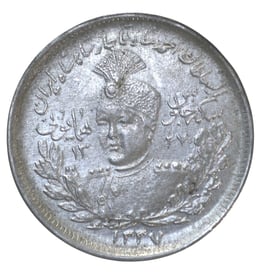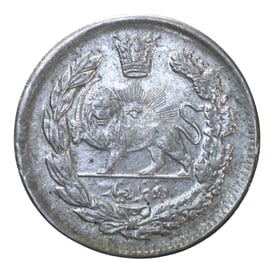10th Anniversary of the Accession of Ahmad Shāh
2/2/20252 min read


The 2000 Dinar coin issued in 1337 AH (1918 CE) to commemorate the 10th Anniversary of Ahmad Shah Qajar’s reign is an important numismatic piece from the late Qajar era, reflecting both the political landscape and the symbolism of the time. Ahmad Shah was the last monarch of the Qajar dynasty, ruling from 1909 to 1925. The coin was minted to celebrate a decade of his reign, an era marked by significant political turmoil, including the Constitutional Revolution and growing foreign influence in Persia.
Key Features of the Coin:
Date and Minting Year: The coin is from 1337 AH, which corresponds to 1918 CE, marking the 10th anniversary of Ahmad Shah's rule. The inscription "سکه جُلوس همایُونی" translates to "Coin of the Imperial Coronation" or "Coin of the Royal Accession", referring to the celebration of his enthronement or his reign's anniversary.
Denomination: The coin is a 2000 Dinar, a significant amount at the time. The dinar was a unit of currency in Persia, and 2000 dinars would have been quite valuable.
Design and Inscription:
Obverse: The coin likely features an inscription of the Shah’s name and titles in Persian, possibly accompanied by a portrait or a royal symbol representing the monarchy, as was typical in the coins issued by the Qajar rulers.
Reverse: On the reverse side, the inscription "سکه جُلوس همایُونی" indicates its role in celebrating the 10th anniversary of Ahmad Shah's rule, possibly alongside other symbols of royal power or Persian heritage, such as a lion or sun motif, which were often used on coins from this period.
Material: The coin is typically made of silver, a common material for coins in this era, though some higher-value denominations were sometimes issued in gold or copper.
Historical Context:
Ahmad Shah Qajar (1909–1925) became king at a young age (he was only 11 years old when he ascended the throne after the deposition of his father, Mohammad Ali Shah Qajar, during the Constitutional Revolution). This resulted in a regency period before he was able to assume full control.
His reign occurred during a time of great upheaval in Persia, with internal struggles for power, foreign intervention, and growing discontent. Ahmad Shah's reign is particularly marked by his inability to effectively assert authority in the face of foreign influence, particularly from the British and Russian Empires, and his eventual deposition by Reza Khan, leading to the rise of the Pahlavi dynasty.
The 10th Anniversary Coin was part of efforts to bolster the legitimacy of Ahmad Shah's rule, as the Qajar dynasty faced increasing challenges and declining power. While the monarchy continued to issue coins like this one, they were often used as a way to maintain a facade of strength and continuity.
Significance of "سکه جُلوس همایُونی":
The inscription “سکه جُلوس همایُونی” specifically commemorates the Royal Accession (Jolous), which is a term used for the coronation or ascension celebrations of a monarch. By issuing this coin, the government likely hoped to promote stability and showcase the Shah's continued rule, even as Persia faced mounting challenges from both internal political movements (such as the Constitutionalists) and external forces.
Numismatic Importance:
The 2000 Dinar coin is a significant piece for collectors and historians, as it encapsulates a critical moment in Iranian history—the final years of the Qajar dynasty before the rise of the Pahlavi regime.
The coin is also interesting because it represents a form of statecraft where coinage played a role in reinforcing the monarchy’s legitimacy during uncertain times.




numismaticfinds@gmail.com
